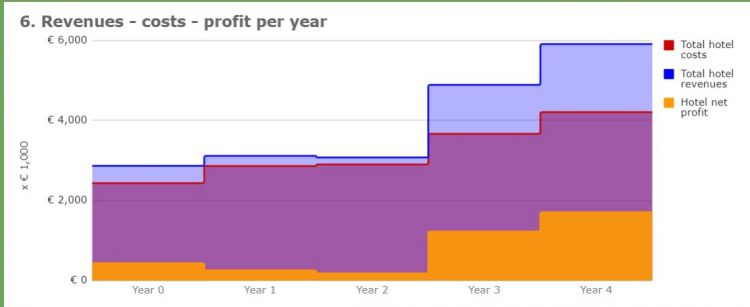Net profit
→ Go! Category:Hotel info
What is net profit?
The net profit consists of the revenues which are made in the four revenue groups:
- Rooms rental
- Food and beverage
- Banqueting
- Other revenues
Minus the total of all the three cost groups: fixed, variable and team decisions. All this is visible in the Operating review.
We only speak of net profit, not of margin, profit or other concepts. We do not look at any corporate tax at all.
There is a special group fines and bonuses which influences the result directly as well.
What remains is the net profit. More info on the page Operating review. As you take over this profit is good, in fact too good. This is caused by the fact that the management who ran the hotel really did as few spendings as possible during the last few years. This has driven up the net profit, but now there is real lag in maintenance and the visitors are getting dissatisfied with the fact that the hotel is outdated.
No taxes
In the data we have of the hotel, there is no information on taxes or VAT (value added tax).
You also do not have to worry about liquidity: it is all about the net profit; so, there is no profit before or after tax. The regulation on taxes and VAT differs from country to country: of course, in the end, the Emerald Forest Hotel will need to meet the legal requirements. Though for now we need to work with the data and numbers available.
Net profit very high
The history of the hotel shows in the last year € 2,861,896 revenues and € 431,301 net profit, that is 15% and very high! How come?
- The data from the history are pre-Corona.
- The hotel hardly invested during the last few years. The Bergman family was cannibalizing the venue, one could say.
- The family never worked with Vertical Search Engines, nor with Affiliate programs and Aggregators, nor with platforms like Bookings, Beter Boeken or Hotels.com. Of course, this means no commissions (up to 25%!) had to be paid. By now, it is impossible to work without any of these.
- Also hardly any costs where made on marketing, staff development, market research or other cost groups. On taking over, you can, no should, work especially on these cost groups via decisions 6-10)
Find some ratio's, benchmarks, information and explanations on small hotels on this page.
Net profit and your operating review
In the game, it is only about the Exploitation (operating review) of the hotel (i.e., the profit or loss the hotel makes in a year). The realized profit in a year will be fully reserved and can't be used to finance the investments or cover the costs of next year(s). In your Team File you will find the profit on the tab 'Results', row 69 and 70 and indicator on the same page as your operating review of each year. To make the development in your profit visible, your net profits (or loss) year by year is summed up.
Your hotel's total profit that was made during the years is shown in the tab Results in the section 'Key Metrics' as 'Total net profit (total of the years)'.
You can't spend this or invest this. You are limited to the limitations of the Yearly decisions.
Though, don't worry about the hotel's 'finances' for realizing and 'paying' for new plans or costs to be made. In any year, you can spend a total amount of € 1,350,000 (= the sum of all possible costs) allowed, which is far beyond realistic costs, looking at a hotel of this size. So, to speak in economical terms: liquidity is no issue, do not worry how costs are paid for-financed, just beware that you make results.
Costs made in the history
As suggested, your hotel should probably 'activate' the aforementioned six cost groups (decisions 6 till 10) to keep the company healthy and valuable to customers.
Compensating for these additional costs you will make compared to the history, or rather benefiting from them, can only be done in a few ways:
- More revenues by choosing higher prices, so a higher profit per sold product;
- More revenues by achieving a higher occupancy-rate, so more sales.
- Make fewer costs per room as you have a higher occupancy rate;
- Make costs hoping that -by making them- dissimilar costs are brought down (for instance, in using ICT, less staff is needed);
All the fixed costs cannot be influenced at all. The variable costs will automatically be calculated related to your occupancy rate.
There are also pages on the revenues per room: RevPOR and RevPAR.
To get a basic idea of what the average profit is per room or per occupied room, we use a ratio called Revenue per room.
→ GO! Top of this page

